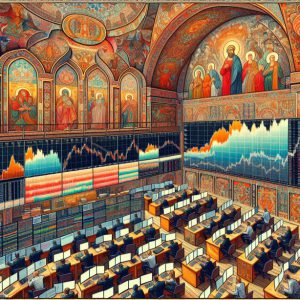
What to Do When the Stock Market Drops: Buy Big
June 11, 2024
Introduction: Embracing Market Crashes with a Contrarian Mindset
In the dynamic world of investing, stock market drops can trigger fear and panic among the general public. However, savvy and contrarian investors perceive these events as moments to “back the truck up” and invest. This article delves into the strategies and mindsets of those who approach market crashes as windows of opportunity. By combining mass psychology, technical analysis, and a long-term perspective, investors can make informed decisions that go against the grain and potentially lead to significant gains.
During market downturns, when others are gripped by fear, contrarian investors recognize the profit potential. They understand that market crashes can create buying opportunities, allowing them to acquire undervalued assets at discounted prices. By celebrating market crashes, these investors position themselves to benefit from the eventual market recovery and rebound.
In the following sections, we will explore the principles and tactics employed by these astute investors. Investors can navigate market crashes effectively and potentially reap substantial rewards by analyzing mass psychology, utilizing technical analysis tools, and adopting a disciplined and patient approach. So, when the market crashes, “back the truck up” and invest with a strategic and contrarian mindset.
Analyzing Market Volatility and the Power of Patience and Discipline
Market volatility often highlights the impact of mass psychology, where news events and false narratives can trigger overreactions, leading to significant market disruptions. For instance, during the volatility of October 2019, the financial markets experienced fluctuations driven primarily by crowd psychology. Benjamin Graham, a pioneer of value investing, wisely stated, “In the short run, the market is a voting machine, but in the long run, it is a weighing machine.” This underscores the importance of maintaining a long-term perspective and avoiding impulsive decisions during market panic.
The 2010 Flash Crash
During the 2010 flash crash, when the S&P 500 declined sharply, astute investors used technical analysis tools such as moving averages and support levels to identify buying opportunities. Their disciplined approach allowed them to profit as the market rebounded. Technical analysis provides a framework for understanding price movements and identifying trends, crucial for making informed investment decisions.
The Brexit Vote in 2016
Volatility and political turmoil can also create market panic and buying opportunities. The Brexit vote in 2016 is a prime example of political turmoil impacting markets. While many investors reacted hastily, astute investors viewed the turmoil as an opportunity to buy undervalued stocks. This required a nuanced understanding of political events and their potential economic implications. As Warren Buffett famously said, “Be fearful when others are greedy, and greedy when others are fearful.” This contrarian mindset is essential for navigating market volatility.
The March 2020 Market Correction
The March 2020 market correction, driven by the coronavirus pandemic, further illustrates the power of contrarian investing. Despite widespread panic and impending doom, astute investors recognized the buying opportunity. As the Dow reached its bottom, a significant reversal occurred, leading to substantial gains for those who bought during the panic. This highlights the importance of maintaining a calm demeanour and focusing on the long-term outlook.
The Role of Discipline and Emotional Control
Patience and discipline are essential for contrarian investing. Astute investors recognize that market panic is often short-lived and focus on the long-term outlook. They maintain a calm demeanour during turbulent times, following the advice of Jack Bogle, the founder of Vanguard, who said, “The key to investing is… determining the appropriate balance between risk and reward.” By staying disciplined and adhering to their investment strategies, astute investors can reap the rewards of their patience.
Combining mass psychology with technical analysis is crucial for astute investors. Understanding market sentiment and using technical indicators can help identify market turning points and navigate crowd behaviour. Jesse Livermore, a legendary trader, advised, “The time of maximum pessimism is the best time to buy, and the time of maximum optimism is the best time to sell.” By recognizing patterns of investor sentiment and using tools like moving averages, relative strength index (RSI), and chart patterns, investors can make informed choices.
Examples of Contrarian Investing in Action
John Templeton During the Great Depression
One of the most famous examples of contrarian investing is John Templeton’s approach during the Great Depression. While others were panic-selling, Templeton bought 100 shares of each NYSE-listed company trading below $1, including 34 companies that were in bankruptcy. His contrarian strategy paid off handsomely, laying the foundation for his investment success.
Warren Buffett During the 2008 Financial Crisis
More recently, during the global financial crisis of 2008-2009, contrarian investors like Warren Buffett and Seth Klarman were buying stocks while others were frantically selling. They recognized that the market had overreacted and that many quality companies were trading at substantial discounts to their intrinsic value. By having the courage to be contrarian and invest during times of fear, they positioned themselves for significant gains as the market recovered.
Ancient Wisdom on Contrarian Strategies
The concept of contrarian investing is not new, and even ancient philosophers offered insights into this approach. For example, Sun Tzu, the Chinese military strategist and philosopher, advised, “Appear where you are not expected.” This principle can be applied to investing by seeking opportunities in unexpected places, such as buying when others are selling.
Similarly, the Russian philosopher and writer Leo Tolstoy observed human behaviour and its impact on decision-making. In his novel “Anna Karenina,” he wrote, “Happy families are all alike; every unhappy family is unhappy in its way.” This can be interpreted in an investing context as understanding that market crashes are unique, and each presents a distinct set of opportunities and challenges.
Benjamin Graham: The Father of Value Investing
Benjamin Graham is widely regarded as the father of value investing. He emphasized the importance of long-term thinking and fundamental analysis. He is known for his quote, “In the short run, the market is a voting machine, but in the long run, it is a weighing machine,” highlighting the difference between short-term market fluctuations and long-term value.
Robert Shiller: Understanding Investor Sentiment
Robert Shiller (1946-present) is a renowned economist and Nobel laureate who has extensively studied investor sentiment and market volatility. His research on market bubbles and investor behaviour provides valuable insights into crowd psychology and its impact on asset prices. Shiller’s work underscores the importance of understanding investor sentiment in navigating market volatility.
Combining Mass Psychology and Technical Analysis
Mass psychology plays a crucial role in driving market movements. Investor sentiment, influenced by emotions such as fear and greed, can lead to irrational behaviour and create opportunities for astute investors. Studying market sentiment and investor behaviour can give insight into potential turning points and trends.
Technical analysis provides tools and indicators to analyze price and volume data, helping investors identify patterns and trends. Combining mass psychology with technical analysis can be a powerful strategy for navigating market crashes and making informed investment decisions.
The Dot-Com Bubble
The late 1990s witnessed the dot-com bubble, during which tech stocks experienced a rapid and unsustainable surge in value. However, astute investors who recognized the signs of an overheated market exited their positions before the bubble burst. This example demonstrates the importance of combining mass psychology with technical analysis.
Investors could make informed decisions by understanding market sentiment and using technical indicators such as the advance-decline line and the new highs-new lows index. Those who recognized the excessive optimism and greed prevailing in the market could protect their capital by selling before the crash.
The 2008 Financial Crisis
Similarly, during the 2008 financial crisis, technical analysis provided valuable insights into the severity of the market downturn. Indicators like the VIX (volatility index) and the put-call ratio signalled extreme levels of fear and panic in the market. Investors who understood these signals and had the courage to buy when others were selling were able to capitalize on the subsequent market recovery.
Conclusion: The Market Symphony
Reflective Revelations: Deep Dives into Thoughtful Content

A Novel Idea: Shattering the Myth of the Gold Standard

What are logical positivism examples in investing?

Does Technical Analysis Work? Unveiling The Truth

What is the Gambler’s Fallacy? The Fast Track to Financial Ruin

What does recency bias mean?

As Misinformation Wars Intensify: Stay Alert, Don’t Get Blindsided

S&P 500 Stock Market Crash 2008 Chart: Focus on Opportunity

RSI Divergence: Outsmart the Masses and Triumph in the Markets

Stock Market Turbulence: How to Profit While Others Panic

What is Gambler’s Fallacy in Investing? Stupidity Meets Greed

Stock Market Crash 2008 Chart vs 2020: Don’t Repeat the Mistakes of the Past

What is flocking behaviour?

Collective Psychology: Winning Strategies Against the Masses That Ignore History

What is considered the opposite of recency bias?



